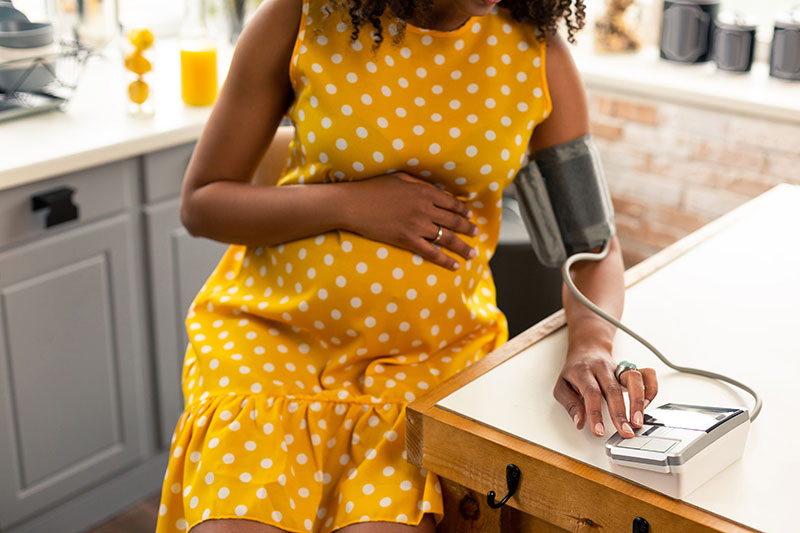High blood pressure during pregnancy poses risks for mother and child

Beth Johnson, then 22 and a Yorkville, Illinois resident, was in premature labor with her eldest child when she learned she had preeclampsia, a dangerous type of hypertension, or high blood pressure, affecting pregnant women. “My blood pressure was so high they were worried I’d have seizures,” said Johnson, who is now 48. “I delivered three weeks early.”
High blood pressure occurs in 1 in every 12 to 17 pregnancies in women between the ages of 20 and 44, and there are several distinct types:
- Preeclampsia. In preeclampsia, high blood pressure is accompanied by signs of damage to other organs such as the liver and kidneys. For example, there may be too much protein in the urine (proteinuria) or impaired kidney function. Preeclampsia can start any time after 20 weeks but is more common during the third trimester. Women with preeclampsia invariably have a small, growth-restricted baby. In women who had normal blood pressure before pregnancy, preeclampsia usually resolves within six weeks of childbirth.
- Chronic hypertension. This occurs in women who already had high blood pressure before becoming pregnant, or when they develop it before 20 weeks of pregnancy. Approximately 20% of women with chronic hypertension also develop preeclampsia in late pregnancy.
Gestational hypertension. This happens when blood pressure becomes elevated during pregnancy. Unlike preeclampsia, however, women with gestational hypertension don’t have protein in their urine or signs of damage to other organs. In contrast to women with preeclampsia, women with gestational hypertension tend to have a normal grown baby.
”While the maternal death rate is low in the U.S., cardiovascular disease is the number one cause, accounting for 10% to 15% of deaths,” said Dr. Stephanie Coulter, the director of the Center for Women’s Heart & Vascular Health at the Texas Heart Institute in Houston.
“It’s rare, but it’s real,” Coulter said.
Preeclampsia, Coulter added, is the worst kind of high blood pressure during pregnancy. “It can lead to eclampsia, which causes seizures in the mother. The mortality rate for that is high.”
Signs and symptoms of preeclampsia include:
- Kidney trouble, such as protein in the urine
- Elevated liver enzymes
- Decreased blood platelets
- Shortness of breath
- Headaches
- Vision changes, including blurriness and sensitivity to light
- Upper abdominal pain
- Nausea and/or vomiting
Women who are obese, or have chronic hypertension or kidney disease, are more likely to develop the condition, as are Black women, very young women and those older than 35. Women who have already had preeclampsia — or whose mother or sister had it — are at greater risk, too.
The condition is also more likely during a woman’s first pregnancy and during first pregnancies with a different father.
In fact, while Johnson didn’t develop preeclampsia during her second pregnancy, when she was 24 weeks pregnant with her third child — the first pregnancy with her second husband, Matt — she was once again diagnosed with the condition.
Too early to deliver safely, doctors placed Johnson on bedrest for the following 16 weeks. In fact, her blood pressure was only normal when she laid on her left side. “It was terrifying,” Johnson said. “They said this could be life-threatening.”
According to Professor David Williams, a consultant obstetric physician at the Institute for Women’s Health, University College London Hospital, hemorrhagic stroke is one of the most dangerous consequences of untreated hypertension, related to preeclampsia.
Conversely, deep vein thrombosis, a blood clot that forms in veins, is another concern, especially for women with heavy proteinuria. To avoid a DVT, he encourages his patients to move around periodically and take a blood thinner.
“The cure of preeclampsia is childbirth. If pre-eclampsia happens after 37 weeks of pregnancy, we get on and deliver the baby. Before 34 weeks, we deliver the baby if it stops growing or if the mother’s blood pressure becomes difficult to control. Between 34-37 weeks, we judge timing of childbirth by balancing measures of maternal and fetal wellbeing,” Williams said.
Years after a pregnancy affected by preeclampsia, women face double the risk of stroke and quadruple the risk of high blood pressure later in life.
In its guidelines for preventing stroke in women, the American Heart Association recommends women with a history of preeclampsia be evaluated regularly starting within a year after giving birth, and be treated for risk factors such as high blood pressure and high cholesterol, as well as avoid obesity and smoking.
Aware of her increased risk for heart disease, Johnson sees her doctor every six months and takes medication to control her blood pressure, which remains stable.
The Johnsons also heeded their doctor’s advice against having more children through natural childbirth. Instead, they’ve adopted three more children, resulting in a blended family with six kids between the ages of 8 and 26.

“It impacted the way my family was formed, which I’m incredibly thankful for,” Johnson said, noting they are all very close despite the difference in their ages. “As difficult as it was to go through that, it was part of our journey.”






